Educational Measurement and Evaluation
Educational Measurement and Evaluation. Myrna E. Lahoylahoy, Ph.D. Measurement defined. Process of quantifying individual’s achievement, personality, attitudes, habits and skills Quantification appraisal of observable phenomena Process of assigning symbols to dimensions of phenomena
Share Presentation
Embed Code
Link
Download Presentation

walterpark + Follow
Download Presentation
Educational Measurement and Evaluation
An Image/Link below is provided (as is) to download presentation Download Policy: Content on the Website is provided to you AS IS for your information and personal use and may not be sold / licensed / shared on other websites without getting consent from its author. Content is provided to you AS IS for your information and personal use only. Download presentation by click this link. While downloading, if for some reason you are not able to download a presentation, the publisher may have deleted the file from their server. During download, if you can't get a presentation, the file might be deleted by the publisher.
Presentation Transcript
- Educational Measurement and Evaluation Myrna E. Lahoylahoy, Ph.D.
- Measurement defined • Process of quantifying individual’s achievement, personality, attitudes, habits and skills • Quantification appraisal of observable phenomena • Process of assigning symbols to dimensions of phenomena • An operation performed on the physical world by an observer • Process by which information about the attributes or characteristics of things are determined and differentiated
- Evaluation defined • Qualitative aspect of determining the outcomes of learning. • Process of ranking with respect to attributes or trait • Appraising the extent of learning • Judging effectiveness of educ. experience • Interpreting and analyzing changes in behavior • Describing accurately quantity and quality of thing • Summing up results of measurement or tests giving meaning based on value judgments • Systematic process of determining the extent to which instructional objectives are achieved • Considering evidence in the light of value standard and in terms of particular situations and goals which the group of individuals are striving to attain.
- TESTING – a technique of obtaining information needed for evaluation purposes. Tests, Quizzes, measuring instruments – are devices used to obtain such information
- FUNCTIONS OF MEASUREMENTS 1. INSTRUCTIONAL a) Principal (basic purpose) - to determine what knowledge, skills, abilities, habits and attitudes have been acquired - to determine what progress or extent of learning attained - to determine strengths, weaknesses, difficulties and needs of students
- FUNCTIONS OF MEASUREMENTS 1.b) Secondary (auxiliary functions for effective teaching and learning) - to help in study habits formation - to develop the effort-making capacity of students - to serve as aid for guidance, counselling, and prognosis
- FUNCTIONS OF MEASUREMENTS 2. ADMINISTRATIVE/SUPERVISORY - to maintain standards - to classify or select for special purposes - to determine teachers efficiency, effectiveness of methods, strategies used (strengths, weaknesses, needs); standards of instruction - to serve as basis or guide for curriculum making and developing
- Administrative / supervisory Function - to serve as guide in educational planning of administrators and supervisors - to set up norms of performance - to inform parents of their children’s progress in school - to serve as basis for research
- Functions of Evaluation 1. Evaluation assesses or make appraisal of - Educational objectives, programs, curricula, instructional materials, facilities - Teacher - Learner - Public relations of the school - achievement scores of the learner 2. Evaluation conducts research
- Principles of Evaluation Evaluation should be 1. Based on clearly stated objectives 2. Comprehensive 3. Cooperative 4. Used Judiciously 5. Continuous and integral part of the teaching – learning process
- Types of Evaluation used in classroom instruction • Diagnostic Evaluation – detects pupil’s learning difficulties which somehow are not revealed by formative tests. It is more comprehensive and specific. • Formative Evaluation – It provides feedback regarding the student’s performance in attaining instructional objectives. It identifies learning errors that neded to be corrected and it provides information to make instruction more effective.
- Types of Evaluation used in classroom instruction 3. Placement Evaluation – It defines student’s entry behaviors. It determines knowledge and skills he possesses which are necessary at the beginning of instruction. 4. Summative Evaluation – It determines the extent to which objectives of instruction have been attained and is used for assigning grades/marks and to provide feedback to students.
- Qualities of a Good Measuring Instrument • VALIDITY Content, concurrent, predictive, construct • RELIABILITY adequacy, objectivity, testing condition, test administration procedures • USABILITY (practicality) ease in administration, scoring, interpretation and application, low cost, proper mechanical make – up
- VALIDITY Content validity – face validity or logically validity used in evaluating achievement test Concurrent validity – test agrees with or correlates with a criterion (ex. entrance examination) Predictive validity – degree of accuracy of how test predicts the level of performance in activity which it intends to foretell Construct validity – agreement of the test with a theoretical construct or trait (ex. IQ)
- Let’s have a problem situation: A fisherman who captures on piece of yellow fin tuna weighs it and it measures 100 kilograms. As he meets a friend after friend, he tells that the weight of the fish he caught is 130 kilo grams. In statistical sense, the story is reliable for it is consis-tent (why is it consistent), but the truth-fulness of the fisherman’s story is not established, hence it is not valid but reliable. LESSON: A test can be reliable without being valid but a valid test is reliable.
- RELIABILITY Methods of estimating reliability • Test-retest Method (uses Spearman rank correlation coefficient) • Parallel forms / alternate forms ( paired observations are correlated) • Split-half method (odd-even halves and computed using Spearman Brown formula) • Internal-consistency method (Kuder-Richardson formula 20) • Scorer reliability method (two examiners independently score a set of test papers then correlate their scores)
- TESTS Classification of Tests according to manner of response: Oral and Written according to method of preparation: Subjective/essay and Objective according to nature of answer Intelligence test, Personality test, Aptitude test, Prognostic test, Diagnostic test, Achievement test, Preference test, Accomplishment test, Scale test, Speed test, Power test, Standardized test, Teacher – made test, Placement test
- Classification of Measuring Instrument • Standard Tests a) Psychological test – Intelligence test, Aptitude test, Personality (Rating scale) test, Vocational and Professional Interest Inventory b) Educational Test 2. Teacher – made test Planning, Preparing, Reproducing, Administering, Scoring, Evaluating, Interpreting
- Evaluating with the use of ITEM Analysis • Effectiveness of distractors A good distractor attracts the student in the lower group than in the upper group • Index of discrimination The index of discrimination may be positive if more students in the high group got the correct answer and negative if more students in the low group got the correct answer. • Index of difficulty Difficulty refers to the of getting the right answer of each item. The smaller the percentage, the more difficult the item is.
- Practice Task in Item AnalysisTest Item no. 5 Options 1 2 3* 4 5 Upper 27% 2 3 7 2 0 (14) Lower 27% 4 2 3 5 0 (14) *correct answer
- Types of Teacher – Made Tests • Essay type Advantages: easy to construct, economical, minimize guessing, develops critical thinking, minimize cheating and memorizing, develops good study habits • Objective type a) Recall type – simple recall, completion type b) Recognition type – alternate response (true/false, yes/no, right/wrong, agree/disagree); Multiple choice (stem-and-options variety, setting-and-options variety, group-term variety, structured – response variety, contained-option variety) c) Matching type d) Rearrangement type e) Analogy type – purpose, cause and effect, synonym relationship, antonym relationship, numerical relationship f) Identification type
- Multiple Choice Test(Recognition type) 1.stem-and-options variety : the stem serves as the problem 2.setting-and-options variety : the optional respon-ses are dependent upon a setting or foundation of some sort, i.e. graphical representation 3.group-term variety : consist of group of words or terms in which one does not belong to the group 4.structured – response variety: makes use ofstructured response which are commonly use in classroom testing for natural science subjects 5.contained-option variety: designed to identify errors in a word, phrase, sentence or paragraph.
- Analogy 1.Purpose : shoe is to shoelace as door is to ___ a. transom b. threshold c. hinge d. key 2.cause and effect : heat is to fire as water is to _ a. sky b. rain c. cloud d. H2O 3.synonym relationship: dig is to excavate as kill is to a. try b. avenge c. convict d. slay 4.antonym relationship: fly is to spider as mouse is to a. rat b. cat c. rodent d. animal 5.numerical relationship: 2 is to 8 as 1/3 is to __ a. 2/3 b. 4/3 c. 12 d. 4
- Table of Specifications (TOS) It is the teacher’s blue print. It determines the content validity of the tests. It is one- way table that relates the instructional objectives to the course content It makes use of Bloom’s Taxonomy in determining the Levels of Cognitive Domain
- TOS Matrix
- Criterion and Norm Reference Tests Criterion-Reference Tests It serves to identify on what extent the individual’s performance has met in a given criterion. (ex. A level of 75% score in all the test items could be considered a satisfactory performance) It points out what a learner can do, not how he compares with others It identifies weak and strong points in an individual’s performance It tends to focus on sub skills, shorter, mastery learning It could be both diagnostic and prognostic in nature.
- Criterion and Norm Reference Tests Norm-Referenced Tests It compares a student’s performance with the performance of other students in the class It uses the normal curve in distributing grades of students by placing them either above or below the mean. The teacher’s main concern is the variability of the score. The more variable the score is the better because it can determine how individual differs from the other. Uses percentiles and standard scores. It tends to be of average difficulty.
- Measures of Central Tendency Mean, Median, Mode • Measures of Variability Range, Quartile Deviation, Standard Deviation • Point Measures Quartiles, Deciles, Percentiles
- Measures of Central Tendency MODE – the crude or inspectional average measure. It is most frequently occurring score. It is the poorest measure of central tendency. Advantage: Mode is always a real value since it does not fall on zero. It is simple to approximate by observation for small cases. It does not necessitate arrangement of values. Disadvantage: It is not rigidly defined and is inapplicable to irregular distribution What is the mode of these scores? 75,60,78, 75 76 75 88 75 81 75
- Measures of Central Tendency MEDIAN – The scores that divides the distribution into halves. It is sometimes called the counting average. Advantage: It is the best measure when the distribution is irregular or skewed. It can be located in an open-ended distribution or when the data is incomplete (ex. 80% of the cases is reported) Disadvantage: It necessitates arranging of items according to size before it can be computed What is the median? 75,60,78, 75 76 75 88 75 81 75
- Measures of Central Tendency MEAN – The most widely used and familiar average. The most reliable and the most stable of all measures of central tendency. Advantage: It is the best measure for regular distribution. Disadvantage: It is affected by extreme values What is the mean? 75,60,78, 75 76 75 88 75 81 75
- Point Measures: Quartiles point measures where the distribution is divided into four equal parts. Q1 : N/4 or the 25% of distribution Q2 : N/2 or the 50% of distribution ( this is the same as the median of the distribution) Q3 : 3N/4 or the 75% of distribution
- Point Measures: Deciles point measures where the distribution is divided into 10 equal groups. D1 : N/10 or the 10% of the distribution D2 : N/20 or the 20% of the distribution D3 : N/30 or the 30% of the distribution D4 : N/40 or the 40% of the distribution D5 : N/50 or the 50% of the distribution D…. D9 : N/90 or the 90% of the distribution
- Point Measures: Percentiles point measures where the distribution is divided into 100 equal groups P1 : N/1 or the 1% of the distribution P10 : N/10 or the 10% of the distribution P25 : N/25 or the 25% of the distribution P50 : N/50 or the 50% of the distribution P75 : N/75 or the 75% of the distribution P90 : N/90 or the 90% of the distribution P99 : N/99 or the 99% of the distribution
- Measures of Variability or Scatter 1. RANGE R = highest score – lowest score 2. Quartile Deviation QD = ½ (Q3 – Q1) It is known as semi inter quartile range It is often paired with median
- Measures of Variability or Scatter: STANDARD DEVIATION • It is the most important and best measure of variability of test scores. • A small standard deviation means that the group has small variability or relatively homogeneous. • It is used with mean.
- TABLE 1
- MEAN Mean = fM f fM – total of the product of the frequency (f) and midpoint (M) f – total of the frequencies
- MEDIAN • Median = L + c [N/2 - cum f
- MODE MODE = LMo + c/2 [ f1 – f2 ] [2fo – f2 – f1] LMo – lower limit of the modal class c – class interval f1 – frequency of class after modal class f2 – frequency of class before modal class f0 – frequency of modal class
- The End Thank you for listening (“,)

educational evaluation
World Academic Research Center, Inc. (WARC) is a highly qualified and experienced professional organization dedicated to providing high quality, fast and efficient evaluation and translation services at excellent rates. /nFor More Details visit us at http://www.foreigndegrees.com/
271 views • 5 slides

Progress and Performance Measurement and Evaluation
Progress and Performance Measurement and Evaluation. Chapter 13. Project Monitoring System for Control. Information System Structure What data are collected? Current status of project (schedule and cost) Remaining cost to compete project Date that project will be complete
687 views • 44 slides
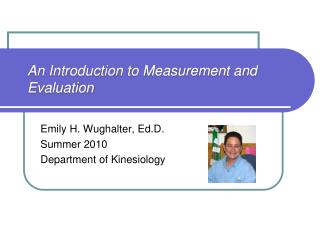
An Introduction to Measurement and Evaluation
An Introduction to Measurement and Evaluation. Emily H. Wughalter, Ed.D. Summer 2010 Department of Kinesiology. Practice, Practice, Practice Focus Challenge. Course Objectives. Students will be able to:
1.05k views • 18 slides
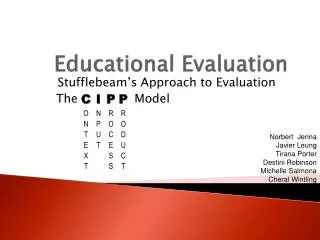
Educational Evaluation
Educational Evaluation. C ONTEXT I NPUT P ROCESS P RODUCT. Stufflebeam’s Approach to Evaluation The Model. Norbert Jerina Javier Leung Tirana Porter Destini Robinson Michelle Salmona Cheral Wintling. The CIPP Model. Table of Contents Biography
683 views • 11 slides
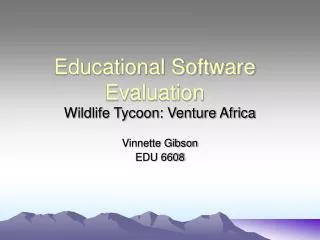
Educational Software Evaluation
Educational Software Evaluation. Wildlife Tycoon: Venture Africa Vinnette Gibson EDU 6608. Does it Teach Intended Concepts?. Wildlife Tycoon: Venture Africa teaches the importance of a balanced ecosystem and preservation of an environment. Concepts Concise and Clear.
276 views • 20 slides

An Introduction to Measurement and Evaluation
An Introduction to Measurement and Evaluation. Emily H. Wughalter, Ed.D. Summer 2008 Department of Kinesiology. Practice, Practice, Practice Focus Challenge. Course Objectives. Students will be able to:
366 views • 17 slides
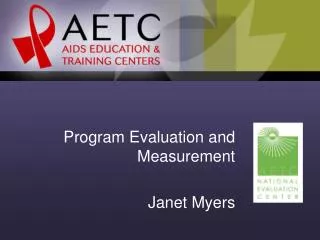
Program Evaluation and Measurement Janet Myers
Program Evaluation and Measurement Janet Myers. Objectives for today…. To define and explain concepts and terms used in program evaluation. To understand the role of evaluation in planning and implementing health programs.
409 views • 33 slides
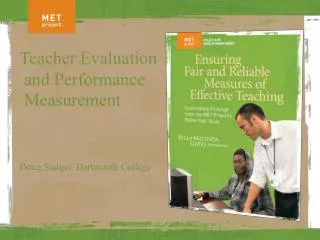
Teacher Evaluation and Performance Measurement
Doug Staiger , Dartmouth College. Teacher Evaluation and Performance Measurement. Not this. Satisfactory (or equivalent) Unsatisfactory (or equivalent) .
710 views • 61 slides
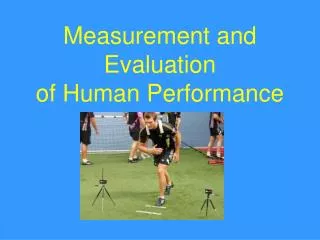
Measurement and Evaluation of Human Performance
Measurement and Evaluation of Human Performance. Fitness – consists of two parts 1. Health Related Factors 2. Skill Related Factors Both are required in all activities but the importance of each may vary. Examples: Runner, Tennis… .
1.17k views • 77 slides
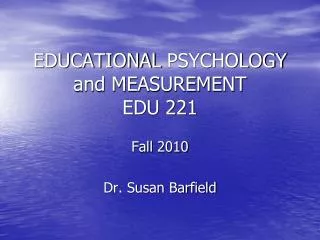
EDUCATIONAL PSYCHOLOGY and MEASUREMENT EDU 221
EDUCATIONAL PSYCHOLOGY and MEASUREMENT EDU 221. Fall 2010 Dr. Susan Barfield. Course Overview. Instructor Introduction Student Introduction Student Information Sheet Syllabus Technology Component Electronic Syllabus MSU-B Student email account MSU-B Desire to Learn (D2L)
169 views • 7 slides
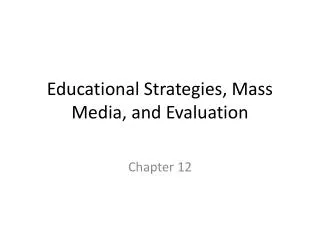
Educational Strategies, Mass Media, and Evaluation
Educational Strategies, Mass Media, and Evaluation. Chapter 12. Key Terms. Teaching Techniques – means in which educational objectives are achieved to create meaningful learning experiences
690 views • 50 slides
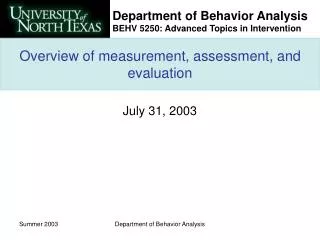
Overview of measurement, assessment, and evaluation
Overview of measurement, assessment, and evaluation. July 31, 2003. Today’s agenda. Welcome (5 minutes) Please remember to click Bonus for reminding me about Free/Writes Questions & answers (5 minutes) Student presentations (45 minutes) Difficult to discriminate stimuli
500 views • 32 slides

Measurement and Data Evaluation Course
Measurement and Data Evaluation Course. Module 14 - Soil Classification with KSSL and field lab data. Why is this topic important?. Proper taxonomic classification of soils often requires laboratory data whether it comes from the KSSL or your office lab
461 views • 36 slides

Evaluation and Measurement
Evaluation and Measurement. Spring 2010 Quality Training Certificate Program. Quality Training Certificate Program. Certificate Details:
700 views • 54 slides
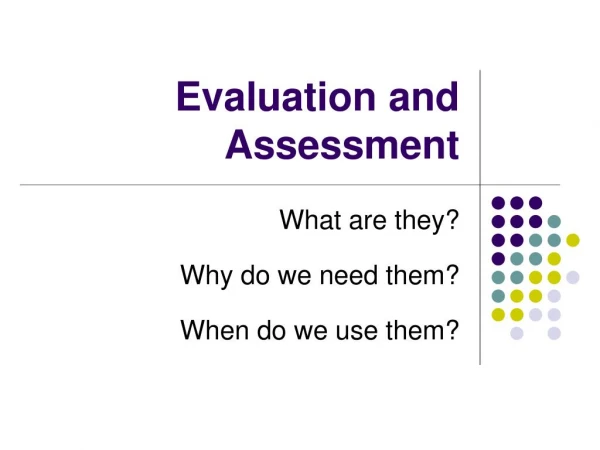
Measurement Evaluation
211 views • 17 slides

Performance Measurement and Evaluation
Performance Measurement and Evaluation. Chapter 19. Chapter Overview. Purchasing and supply chain performance measurement and evaluation Purchasing and supply chain performance measurement categories Developing a performance measurement and evaluation system. Chapter Overview.
493 views • 40 slides

Measurement & Evaluation
Measurement & Evaluation. Reasons for Measuring Campaign Effectiveness. To help all brand stakeholders understand the link between marketing investment and return on investment To evaluate alternative strategies To increase the efficiency and effectiveness of the IMC campaign
162 views • 14 slides

Introduction to Measurement and Evaluation
Introduction to Measurement and Evaluation. PE 254. Test and Data. Test: An instrument or activity used to accumulate data on a person’s ability to perform a specified task. In kinesiology the content of these tests are usually either cognitive, skill, or fitness.
249 views • 18 slides

An Introduction to Measurement and Evaluation
An Introduction to Measurement and Evaluation. Emily H. Wughalter, Ed.D. Summer 2008 Department of Kinesiology. Practice, Practice, Practice Focus Challenge. Course Objectives. Students will be able to:
246 views • 17 slides





















